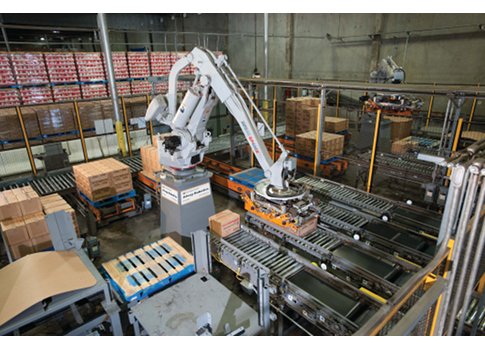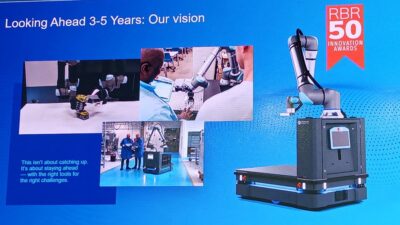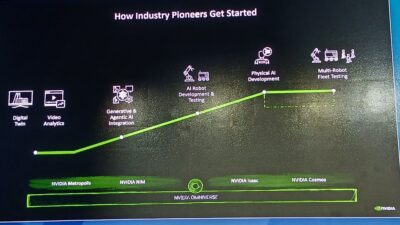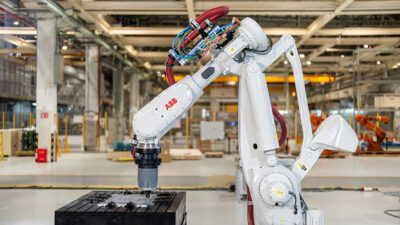Open robotic control: For facilities that already use programmable logic controllers (PLCs) for other machine control functions, integrating robotic control into a PLC may be a wiser choice than relying on the controller provided by the robot manufacturer. Here’s what to consider.

As more manufacturing facilities and distribution centers discover the benefits of robotic material handling solutions, they must decide how best to control the robot. While robot original equipment manufacturers (OEMs) offer their own tightly integrated controller, recent developments have enabled control by a programmable logic controller, or PLC. For facilities that already use PLC-based controls for other machine control functions, integrating robotic control into a PLC may be a wiser choice than relying on an OEM proprietary controller.
Speaking robot just got easier
Most engineers and technicians already understand PLCs and therefore can read and troubleshoot a PLC-based robot system without learning a proprietary OEM control language. While operators still need to understand how robots operate, leveraging existing PLC knowledge greatly reduces training time required to manage, maintain, and operate robotic systems. PLC controls further streamline operations with:
- Common programming controls (software, cables, etc.)
- Common software interfaces
- Common program backup/restore methodology
- Common program documentation.
Simplified robot control interface
Robotic material handling solutions are often complex systems that integrate robotic equipment with nonrobotic systems. Common system components can include infeed and discharge conveyors, pallet dispensers, and transfer cars. Since PLCs typically control nonrobotic system components, robotic controllers must interface to the system controller, handshaking data, and interlocks to achieve desired functionality. Depending on the complexity of the application, interfacing different control modules can pose quite a challenge.
However, consolidating control over robots and other system components into the same PLC eliminates the interface point between separate control systems, greatly reducing system complexity. For example, one controller can handle multiple processes and equipment with the same hardware and software platform, reducing integration and development costs for OEMs and lifecycle costs for end users.
Shared control architecture
PLC-based robotic controllers use the same control architecture as other facility machinery, enabling one point of control over traditional automation equipment and robots. Robot controls use the same drawing nomenclature (wire number, draw numbering, etc.) as other hardware in the same control panel, reducing control system design complexity. Additional benefits of common controls architecture include:
- Simplified troubleshooting and maintenance
- Reduced panel footprint
- Simplified training
- Common spare parts
- Common part numbering scheme.
Easier robotic communications
The bulk of proprietary OEM controllers’ input/output (I/O) communications involve interfacing the robotic controller with the PLC. However, PLC-based robotic controls eliminate this extra communication and instead directly interface with the I/O of the robot, an operation as simple as any other I/O communication in the control system. In addition to simplifying I/O communication, PLC-based robotic controls enable operators to use hardware, I/O, and communications protocols available to the PLC, rather than those from the OEM controller. Since PLC-based robotic controls support a wider range of I/O hardware and communications protocols than OEM controllers do, they more easily accommodate and integrate with more system control applications.
A common interface
With PLC-based robotic controls, the human machine interface (HMI) is consistent through the system and the teach pendent is no longer the primary interface with the robot controller. The alarm system, fault recording, data monitoring, and all other functions available to the HMI now directly interface with the robot controller. Unique faults and custom operations also can be added and changed directly to the robot controller. The HMI interface allows for a much greater application-specific focus and a considerably more agile structure with simplified operator training.
Lower maintenance, upgrade costs
Manufacturing facilities integrate many types of machinery and typically favor PLC-based controls for equipment such as fillers, packers, palletizers, wrappers, and conveyors. If each OEM supplies a unique control scheme, the integrated system may be functional but a nightmare to maintain and upgrade. For this reason, most manufacturing facility requests for proposal (RFPs) place boundaries on the controllers and hardware OEMs can use.
A common control system enables easier upgrades and maintenance, and reduces total cost of ownership. In this respect, integrating the robot controller with the PLC-based control system saves end users additional costs of a unique robotic control design, resulting in a lower total cost of ownership.
More compatibility, robot choices
Due to the specialized nature of OEM robot controllers and related training requirements, many operations that already use industrial robots prefer to stick with the facility’s incumbent robot brand. This often deters companies from selecting the best-fit robot model due to unwillingness to support multiple robot brands or interface different OEM controls. Since PLC-based robotic controllers can be common across multiple brands, end users are no longer “locked in” to their initial robot brand when selecting future solutions.
PLC-based robotic controls introduce a new set of decisions for robotic integrators. Despite certain advantages, system integrators and others can see that PLC-based controls are not always the best choice. Robot-intensive environments, such as the automotive industry, may be unlikely to switch from OEM controllers due to a large install base and highly specialized application requirements. Furthermore, some robot OEMs do not offer a way of provisioning a PLC-based controller.
When making a robotic controller decision, operations must consider availability, functionality, and cost. In facilities with a sizeable installed base of PLC machine controls for the robot to interface with, the technical staff’s familiarity with PLC controls over a unique OEM controller can significantly affect operational and support costs. A reputable certified robotic integrator will work to provide a best-fit final solution, whether PLC- or OEM-based.
– Matt Wicks, vice president, systems engineering, manufacturing systems, at Intelligrated has more than 18 years of experience in the material handling industry with expertise in the areas of controls and software integration for high-volume facilities as well as unique build-to-order fulfillment solutions. He holds a bachelor of science degree in electrical engineering from the University of Missouri – Rolla (Missouri S&T) and currently serves on the university’s corporate development council. Wicks is a registered Professional Engineer in the state of Missouri and currently resides in St. Charles, Mo.; edited by Mark T. Hoske, content manager, CFE Media, Control Engineering and Plant Engineering, [email protected].
ONLINE
Key concepts
- PLC-based robotic controls can lower overall cost of ownership, unifying control.
- Programming, training, and communications can be easier.
- Some robot manufacturers do not allow PLC control.
Consider this
- How could one less control environment benefit robotic workcell integration?



